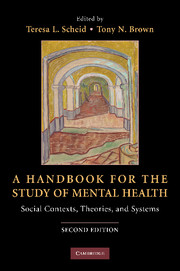16 results
Contributors
-
-
- Book:
- Ultrasonography in Reproductive Medicine and Infertility
- Published online:
- 07 September 2011
- Print publication:
- 25 March 2010, pp ix-xii
-
- Chapter
- Export citation
Contributors
-
-
- Book:
- A Handbook for the Study of Mental Health
- Published online:
- 05 June 2012
- Print publication:
- 16 November 2009, pp xi-xiv
-
- Chapter
- Export citation
References
-
- Book:
- A Handbook for the Study of Mental Health
- Published online:
- 05 June 2012
- Print publication:
- 16 November 2009, pp 589-706
-
- Chapter
- Export citation
Part II - The Social Context of Mental Health and Illness
-
-
- Book:
- A Handbook for the Study of Mental Health
- Published online:
- 05 June 2012
- Print publication:
- 16 November 2009, pp 163-406
-
- Chapter
- Export citation
A Handbook for the Study of Mental Health Second Edition - Half title page
-
- Book:
- A Handbook for the Study of Mental Health
- Published online:
- 05 June 2012
- Print publication:
- 16 November 2009, pp i-ii
-
- Chapter
- Export citation
Part III - Mental Health Systems and Policy
-
-
- Book:
- A Handbook for the Study of Mental Health
- Published online:
- 05 June 2012
- Print publication:
- 16 November 2009, pp 407-588
-
- Chapter
- Export citation
Contents
-
- Book:
- A Handbook for the Study of Mental Health
- Published online:
- 05 June 2012
- Print publication:
- 16 November 2009, pp vii-x
-
- Chapter
- Export citation
Dedication
-
- Book:
- A Handbook for the Study of Mental Health
- Published online:
- 05 June 2012
- Print publication:
- 16 November 2009, pp v-vi
-
- Chapter
- Export citation

A Handbook for the Study of Mental Health
- Social Contexts, Theories, and Systems
-
- Published online:
- 05 June 2012
- Print publication:
- 16 November 2009
Index
-
- Book:
- A Handbook for the Study of Mental Health
- Published online:
- 05 June 2012
- Print publication:
- 16 November 2009, pp 707-714
-
- Chapter
- Export citation
Preface
-
- Book:
- A Handbook for the Study of Mental Health
- Published online:
- 05 June 2012
- Print publication:
- 16 November 2009, pp xix-xx
-
- Chapter
- Export citation
Part I - Approaches to Mental Health and Illness: Conflicting Definitions and Emphases
-
-
- Book:
- A Handbook for the Study of Mental Health
- Published online:
- 05 June 2012
- Print publication:
- 16 November 2009, pp 1-162
-
- Chapter
- Export citation
A Handbook for the Study of Mental Health Second Edition - Title page
-
-
- Book:
- A Handbook for the Study of Mental Health
- Published online:
- 05 June 2012
- Print publication:
- 16 November 2009, pp iii-iii
-
- Chapter
- Export citation
Copyright page
-
- Book:
- A Handbook for the Study of Mental Health
- Published online:
- 05 June 2012
- Print publication:
- 16 November 2009, pp iv-iv
-
- Chapter
- Export citation
Contributors
-
-
- Book:
- The Cambridge Handbook of Age and Ageing
- Published online:
- 05 June 2016
- Print publication:
- 01 December 2005, pp xii-xvi
-
- Chapter
- Export citation
An open letter to the President
-
- Journal:
- Psychiatric Bulletin / Volume 12 / Issue 12 / December 1988
- Published online by Cambridge University Press:
- 02 January 2018, p. 554
- Print publication:
- December 1988
-
- Article
-
- You have access
- Open access
- Export citation



